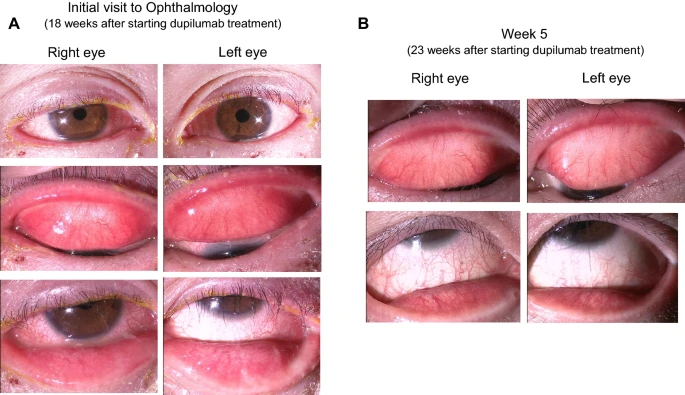- Case report
- Open Access
Allergy, Asthma & Clinical Immunology 18, Article number: 89 (2022)
Abstract
Background
Dupilumab-induced ocular surface disease (DIOSD) has been reported in patients with atopic dermatitis treated with dupilumab, and has been recognized as an adverse event of dupilumab. Our objective was to describe two cases of DIOSD with alterations in eotaxin-2 and interleukin (IL)-8 messenger ribonucleic acid (mRNA) expression on the ocular surface.
Case presentation
In the ocular surface test, specimens were collected from the patient's ocular surface, and eotaxin-2 and IL-8 mRNA levels in the specimens were measured using real-time polymerase chain reaction. The clinical score of ocular surface findings was quantified using a 5-5-5 exacerbation grading scale for allergic conjunctivitis. The first case was of a 27-year-old man who developed DIOSD 3 months after starting treatment with dupilumab injection for atopic dermatitis.
After 5 weeks of topical instillation of tacrolimus ophthalmic suspension, the clinical score of ocular surface findings improved and IL-8 and eotaxin-2 mRNA expression levels gradually decreased. The second patient was a 55-year-old man who developed DIOSD 11 weeks after the start of treatment with dupilumab injection for atopic dermatitis. Four weeks after starting ophthalmological treatment with tacrolimus ophthalmic suspension, his clinical scores on ocular surface findings improved and IL-8 mRNA expression levels decreased. The ocular surface test in this case revealed increased expression levels of IL-8 mRNA on the ocular surface at the onset of DIOSD, which decreased with the improvement of objective findings.Conclusions
DIOSD, which has been successfully treated with tacrolimus ophthalmic suspension, may involve IL-8-related inflammation in addition to type 2 inflammation.

No comments:
Post a Comment